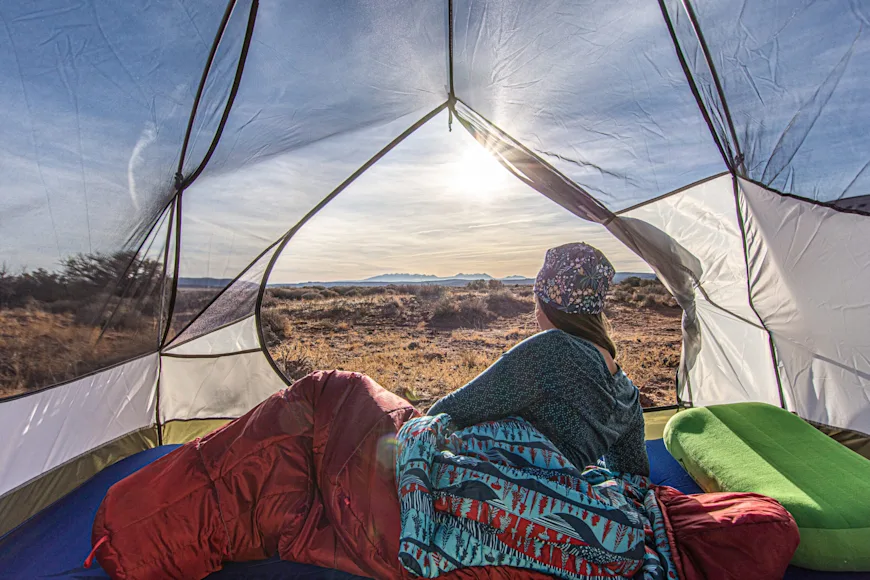_We may earn revenue from the products available on this page and participate in affiliate programs. Learn more ›
_
Best Overall
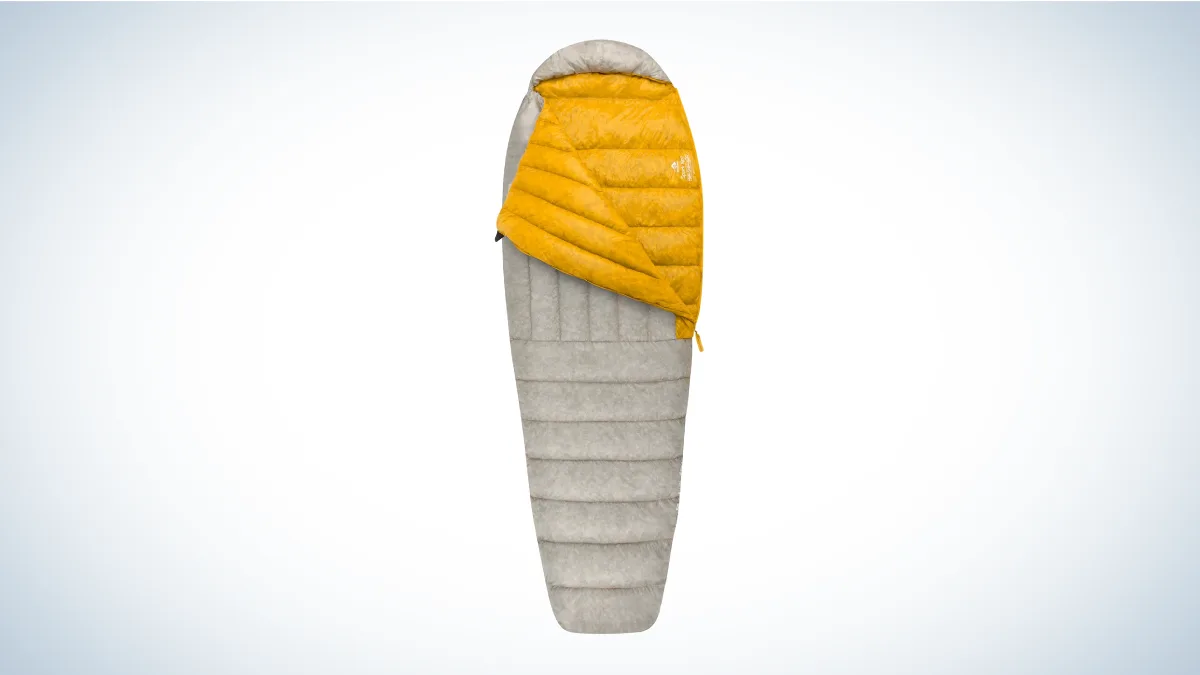
Sea to Summit Spark Ultralight Sleeping Bag
Best Lightweight

Feathered Friends Swallow UL 20/30 Sleeping Bag
Best Budget
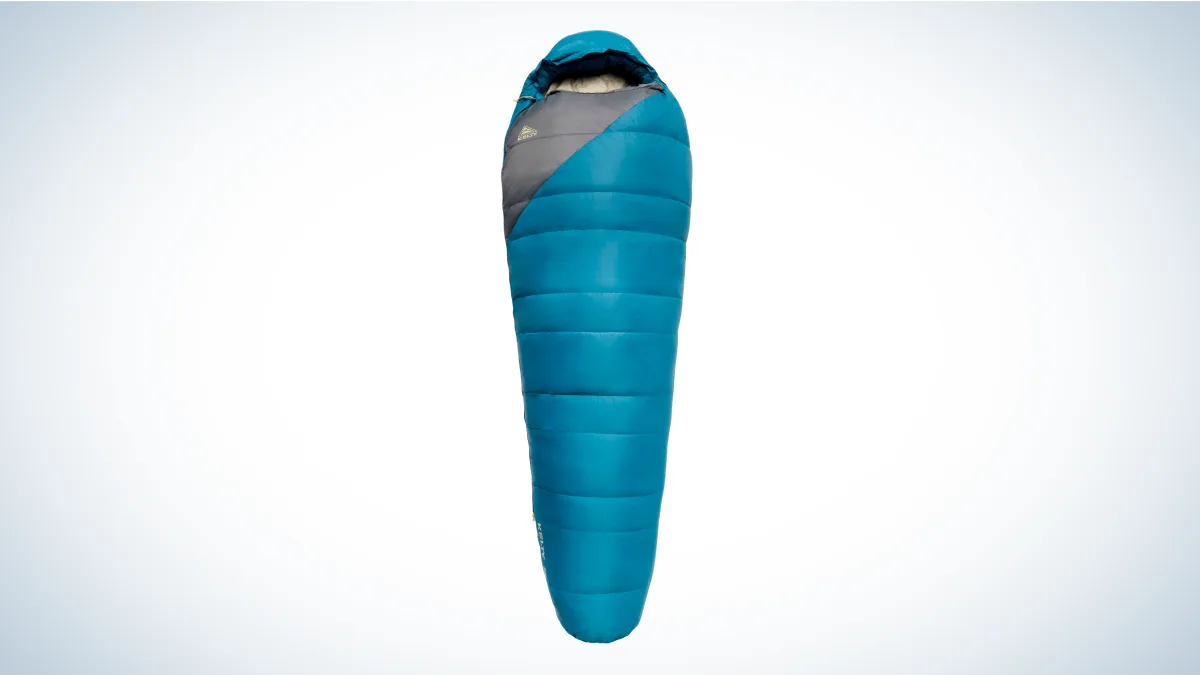
Kelty Cosmic Down 20 Sleeping Bag
Nothing ruins a trip into the backcountry like a bad night’s sleep—which is why we’ve spent thousands of hours testing backpacking sleeping bags to find the most comfortable option for every use and budget. We know you need something that packs down small, keeps you toasty at night, and doesn’t weigh you down on the trail. But with so many quality sleeping bags out there, it can be challenging to choose, especially when you’re trying to fit it into a backpacking backpack
.
We also know that everyone’s needs vary. For instance, the sleeping bag for an ounce-counting thru-hiker may not be the best choice for a beginner on a budget. We understand this, so we’ve tested and ranked the best backpacking sleeping bags by category, along with what to look for when choosing which one is right for you.
Best Overall: Sea to Summit Spark Ultralight Sleeping Bag
Best Lightweight: Feathered Friends Swallow UL 20/30 Sleeping Bag
Best Budget: Kelty Cosmic Down 20
Best Women’s: REI Magma 15 Sleeping Bag
Best 0 Degree: Mountain Hardwear Phantom 0 Sleeping Bag
Best Down: Nemo Disco 30
Best American-Made: Western Mountaineering MegaLite
Best Double: Enlightened Equipment Accomplice
How We Picked the Best Backpacking Sleeping Bags
Our team of avid backpackers has spent countless hours testing sleeping bags
. We’ve gone backpacking in the remote Alaskan wilderness, logged miles on the PCT, and camped out all across Colorado, North Carolina, and Oregon. Our testers paid particular attention to comfort, packability, and durability. We also looked for extra design features and a solid price to weight ratio.
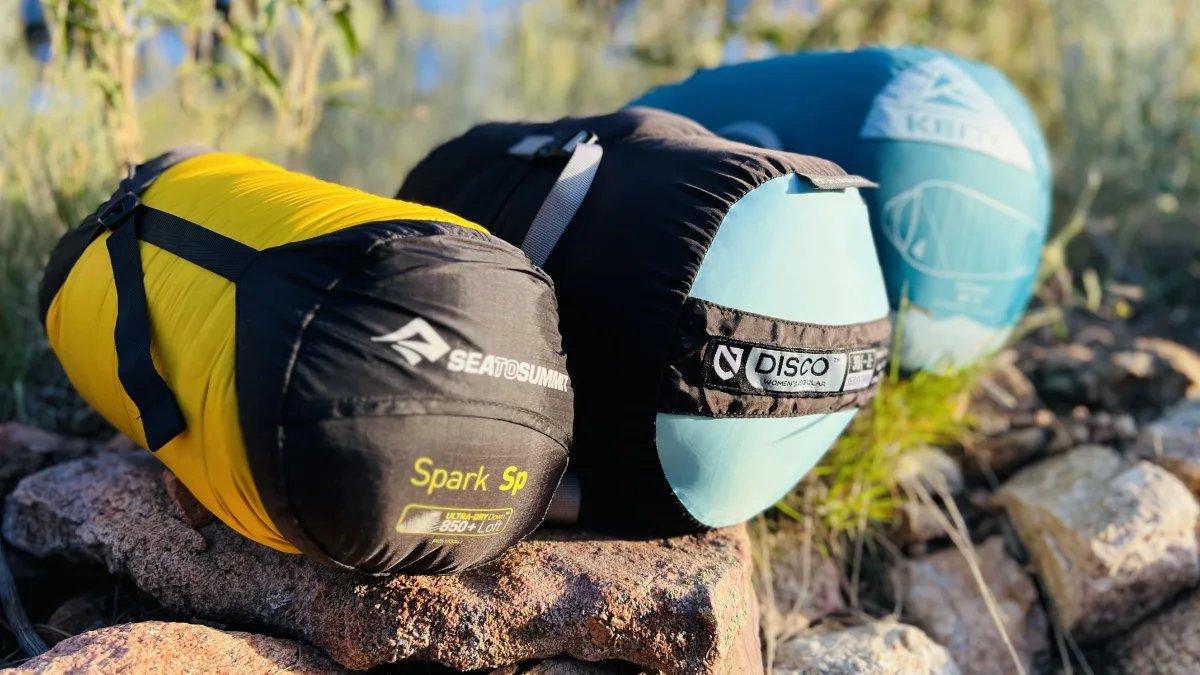
We tested all of the backpacking sleeping bags on the same criteria to choose the top performers. -Mallory Paige
These are some of the most important things we took into consideration:
Temperature rating: Does the sleeping bag have a temperature rating appropriate for the conditions you will be camping in? Of course, everyone has different comfort levels, but we looked for ratings that would keep you warm and comfortable.
Weight: Backpacking sleeping bags need to be lightweight and easy to pack. They shouldn’t weigh down your pack or take up too much space.
Sleep style: Do you sleep on your back, side, or stomach? Some bags are designed specifically for side sleepers, for example.
Durability: Your backpacking sleeping bag will go through a lot of wear and tear, so it must be durable and able to withstand the elements.
Best Backpacking Sleeping Bags: Reviews and Recommendations
Best Overall: Sea to Summit Spark Ultralight Sleeping Bag
Best Overall

Specs
Temperature Rating: 40°F (5°C) for Spark SP I, 28°F (-2°C) for Spark SPII, and 18°F (-8°C) for Spark SP III
Insulation: Ultra-dry 850+ loft goose down
Fill Weight: 6.3 oz for Spark SP I, 12.3 oz for Spark SPII, and 19.4 oz for Spark SP III
Weight: 12 oz for Spark SP I, 1 lb 3 oz for Spark SPII, and 1 lb 10 oz for Spark SP III
Gender: Unisex
Sizes: Regular and long
Pros
Lightweight design makes it ideal for backpacking and other outdoor activities where weight is a concern
Ultra-dry 850+ fill power goose down insulation provides excellent warmth-to-weight ratio and compressibility
Sewn-thru construction reduces weight and bulk
Cons
Sewn-thru construction can create cold spots
With packability comes a slight decrease in durability
Our testers found the Sea to Summit Spark had the right balance of warmth, packability, and affordability. It’s not the absolute warmest or cheapest on this list, but it does the best job riding in the middle and should suit the widest swath of people. Available in a range of temperature ratings, the Spark features high-loft 850+ fill power goose down insulation that provides excellent warmth-to-weight ratio and compressibility.
The sewn-thru construction of the Spark reduces weight and bulk, making it easy to pack and carry in a backpack or other gear. However, the sewn-thru construction can create cold spots, reducing warmth in certain areas of the sleeping bag. We didn’t find this to be a major problem during summer excursions, but if you tend to be cold at night, you may want to consider other options.
We appreciated how easily the Spark packed down to a very small size. The compression-style stuff sack helps shave a few inches off of the overall packed size, and when you’re cramming things into your pack, every little bit counts. Overall, the Sea to Summit Spark is a high-quality sleeping bag that offers excellent warmth and compressibility in a lightweight and compact package. One note: As with all highly packable down sleeping bags, you’ll need to take care not to rip the fabric.
Best Budget: Kelty Cosmic Down 20 Sleeping Bag
Best Budget

Specs
Temperature Rating: 20°F (-7°C)
Insulation: 600-fill DriDown
Fill Weight: 19.5 oz
Weight: 2 lbs 10 oz
Gender: Unisex
Sizes: Regular and long
Pros
Affordable price point compared to other sleeping bags with similar features
Solid warmth-to-weight ratio and compressibility
Mummy shape and draft collar help to retain heat and keep you warm in cold weather conditions
Left and right zipper options allow for easy entry and exit
Cons
600-fill DriDown insulation may not be as warm or compressible as other types of insulation
Drawstring around the hood can occasionally be difficult to adjust
Kelty has long been a top pick for affordability, and that continues with the Kelty Cosmic Down 20. We were very impressed with how it performed, especially considering the price tag. The 600-fill DriDown insulation provides a good warmth-to-weight ratio and compressibility. It doesn’t pack as small as our top pick or most lightweight option, but it is still totally packable. We used the Kelty Cosmic 20 for a three-night stint in the Cascade Mountains and it worked great.
The mummy shape and draft collar help to retain heat and kept us warm in cold weather conditions, while the left and right zipper options allow for easy entry and exit. The sleeping bag comes in two sizes and fits people up to 6-foot-6, making it suitable for a wide range of outdoor activities. We also like the extra little zipper pocket on the inside. It will snugly fit an iPhone 13, but anything larger probably wouldn’t fit.

We liked how well the Kelty Cosmic 20 compressed down into its pack. -Mallory Paige
Overall, the Kelty Cosmic Down 20 is a great sleeping bag for those who prioritize affordability and portability. While it may not be as warm or durable as other sleeping bags we’ve used, it offers good performance at a fraction of the cost.
Best Lightweight: Feathered Friends Swallow UL 20/30 Sleeping Bag
Best Lightweight

Specs
Temperature Rating: 20°F / -7°C
Insulation: 900-fill power goose down
Fill Weight: 19 oz / 539 g
Weight: 2 lb 3 oz / 992 g
Gender: Unisex
Sizes: Regular and long
Pros
Warm 900-fill power goose down insulation packs down well
Water-resistant and durable
Zipper guard helps reduce snagging
Cons
Expensive
Less roomy as other sleeping bags
The Feathered Friends Swallow sleeping bag is a high-quality reliable sleeping bag that is great for longer backpacking trips or ultralight backpacking. Feathered Friends is a popular brand with long-distance backpackers and for good reason. They have a long history of making high-quality gear that packs down small. One of the standout features of the Swallow is its 900-fill power goose down insulation, which provides excellent warmth-to-weight ratio and compressibility. The sleeping bag is rated for 20°F, making it suitable for most seasons and activities.
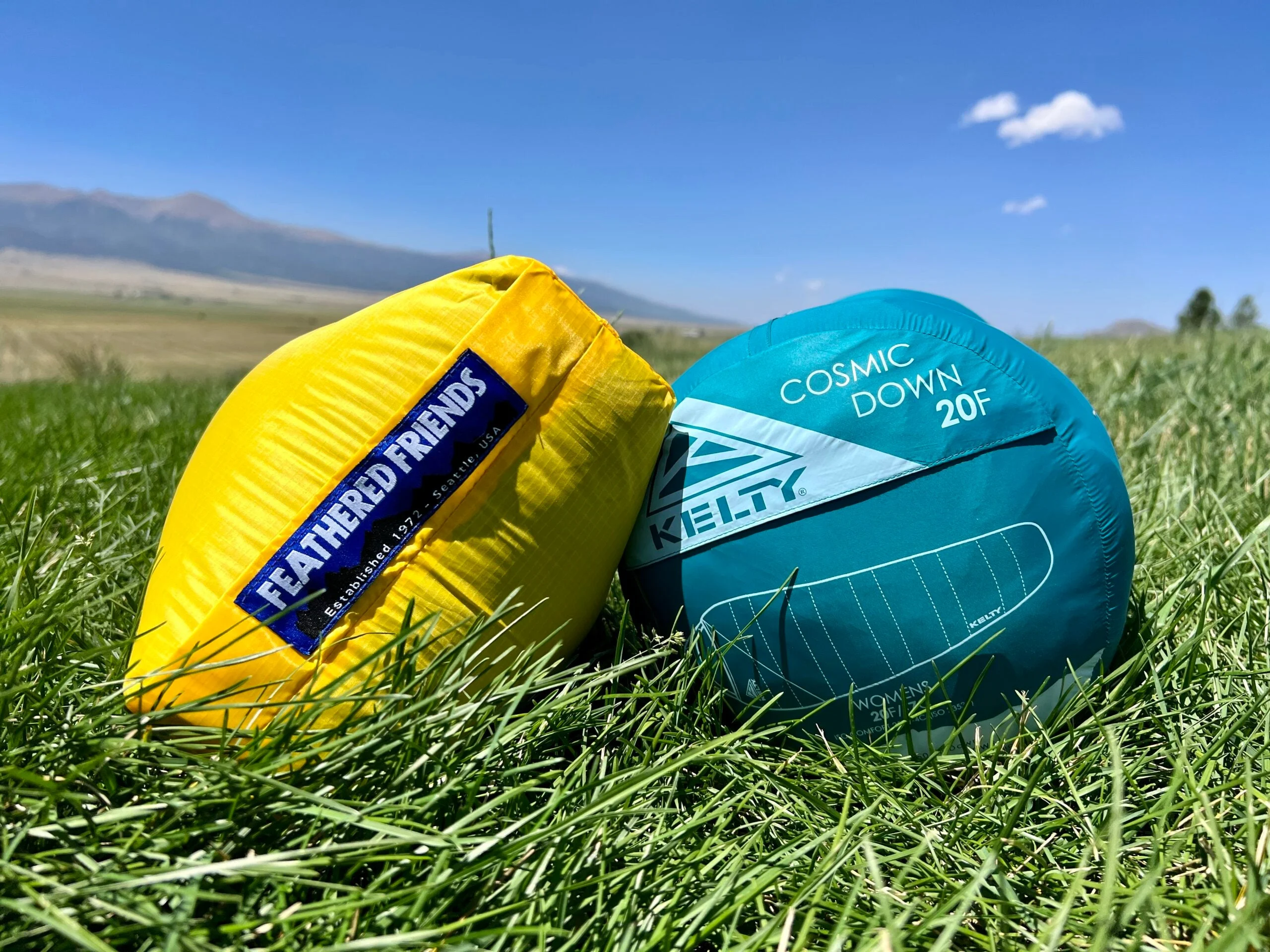
The Feathered Friends Swallow UL—pictured next to the Kelty Cosmic 20—was our favorite lightweight bag of the bunch. -Mallory Paige
Another great feature of the Swallow is its durable Pertex YFuse shell and liner materials, which are water-resistant and able to withstand wear and tear. This sleeping bag is not as roomy as other sleeping bags we’ve used, but the slimmer design definitely helps with packability. We also like that it features a full-length draft tube and draft collar to help prevent cold air from entering and keep you warm throughout the night.
Best Women’s: REI Magma 15 Sleeping Bag
Best Women's

Specs
Temperature Rating: 15°F / -9°C for Magma 15; 30°F / -1°C for Magma 30
Insulation: 850-fill power goose down
Fill Weight: Magma 15: 21.5 oz / 610 g; Magma 30: 12 oz / 340 g;
Weight: Magma 15: 2 lb 2 oz / 964 g; Magma 30: 1 lb 4 oz / 567 g
Gender: Unisex
Sizes: Regular and long
Pros
Superior warmth-to-weight ratio and compressibility
Durable and both rip- and water-resistant
More affordable
Cons
People who sleep hot may find it too warm
The REI Co-op Magma 30 is a top pick from our female testing pool, making it the best women’s backpacking sleeping bag. It offers a great balance of performance and price. One of the standout features is its 850-fill power goose down insulation, which provides exceptional warmth and comfort in a range of temperatures. We also really like the full-length draft tube and draft collar. While some testers who sleep hot found it too warm, other testers appreciated that for once they weren’t shivering at night.
The Magma 30 also earned high marks for packability and weight. Weighing in at just over a pound for the regular size, this sleeping bag is easy to transport and store. Overall, it’s a great choice for anyone looking for a high-quality and lightweight sleeping bag that won’t weigh you down and provides reliable performance in both warm and cold weather conditions.
Best 0 Degree: Mountain Hardwear Phantom 0 Sleeping Bag
Best 0 Degree

Specs
Temperature Rating: 0°F/-18°C
Insulation: 850-fill power down
Fill Weight: 1 lb 14 oz / 850 g
Weight: 2 lbs 10 oz / 1.19 kg; Long – 2 lbs 12 oz / 1.25 kg
Gender: Unisex
Sizes: Regular and long
Pros
Excellent loft and warmth
Packable and comfortable
Cons
Not water-resistant
The Mountain Hardwear Phantom 0 degree sleeping bag is a high-quality mummy sleeping bag that offers ample warmth and comfort for cold weather conditions thanks to the 850-fill power down insulation. We really liked the compressibility, making it a breeze to toss in your pack. At 2 pounds 10.6 ounces, this isn’t the lightest sleeping bag in existence. But for how warm it is, this weight is actually quite minimal.
The 10-denier shell is lightweight, so take care not to rip it. By minimizing the zipper and shell, Mountain Hardwear is able to make a cold-weather bag that packs down surprisingly small. If you’re heading into the backcountry during winter, this is the bag for you.
Best Down: Nemo Disco 30 Sleeping Bag
Best Down

Specs
Temperature Rating: 30°F (-1°C)
Insulation: 650-fill power PFC-free down
Fill Weight: 14 oz
Weight: 2 lbs 4 oz
Gender: Men’s and women’s
Sizes: Regular and long
Pros
Gills provide extra ventilation
Roomy knee design allows for side sleeping
Features a waterproof footbox and hydrophobic down
Cons
Bulkier than slimmer cut designs
If you prefer side sleeping, you’re going to love the Nemo Disco. The sleeping bag is wider at the elbows and knees so you can easily roll over and sleep on your side. No more feeling stuck on your back. Nemo also utilizes “gills” to increase temperature control. These zipper panels allow you to open and close for more breathability as needed.
We found the 650-fill power PFC-free down insulation provided plenty of warmth and the waterproof footbox kept our feet dry during a particularly rainy night in Oregon. The only downside here is weight and packability. The more generous silhouette means more material to pack. That said, it’s still an excellent backpacking sleeping bag. If you’re counting every ounce look elsewhere, but if you’re a side sleeper looking for portable comfort, this is it.
Best American-Made: Western Mountaineering MegaLite
Best American-Made

Specs
Temperature Rating: 30°F / -1°C
Insulation: 850-fill power goose down
Fill Weight: 12 oz / 340 g
Weight: 1 lb 8 oz / 680 g
Gender: Unisex
Sizes: Regular and long
Pros
Made in the USA
Lightweight and packable
Cons
Mummy shape may not be as comfortable as other sleeping bags for some people
Zipper can be difficult to use or may snag
Made in the USA with high-quality materials and construction, this sleeping bag provides excellent warmth-to-weight ratio and compressibility. It only weighs 1.5 pounds, so it’s easy to transport and store, while still maintaining plenty of insulation with an 850-fill.
The MegaLite features a unisex design and is available in a range of sizes to fit different body types and sleeping preferences. The shell and liner materials are made from durable 12D nylon ripstop with DWR, making it water-resistant and able to withstand wear and tear. Overall, the Western Mountaineering MegaLite sleeping bag is a great choice for anyone looking for a high-quality and versatile sleeping bag that is made in the USA and built to last.
Best Double: Enlightened Equipment Accomplice
Best Double

Specs
Temperature Rating: Customizable, options range from 50°F (10°C) to 0°F (-17°C)
Insulation: 850-fill power or 950-fill power goose down
Fill Weight: Varies depending on temperature rating and size
Weight: Varies depending on temperature rating and size
Gender: Unisex
Sizes: Regular, long, and wide
Pros
Goose down insulation provides excellent warmth-to-weight ratio and compressibility
Quilt design is lightweight and easy to pack
Cons
Not be as warm or comfortable as a traditional sleeping bag
Can be difficult to keep in place during the night, which can lead to cold spots
If you really want to shave weight when hiking as a couple or just can’t imagine foregoing bedtime snuggles, it’s worth considering a double sleeping bag. It’s not the most common option, but we know couples who swear by it. While technically a quilt, the Enlightened Equipment Accomplice is the best double sleeping bag for backpacking. It’s packable and warm with both 850-fill and 950-fill options.
Instead of zippers and full coverage, this quilt is designed to work in tandem with your sleeping pad. The included straps help it stay in place and the individual neck baffles allow for temperature control. If you fight over the covers at home, I’d forego this and go with individual pads and sleeping bags. But if you really want to pack minimally and sleep closely, this double quilt is a durable comfortable option.
What to Consider When Choosing a Backpacking Sleeping Bag
Choosing the right sleeping bag is crucial for an enjoyable backpacking trip. While there are several factors to consider, the most important is warmth. You want a sleeping bag that will keep you warm in the coldest temperatures you expect to encounter on your trip. However, you also want to balance warmth with weight and packability, as a heavy and bulky sleeping bag can be a burden on the trail. Other things to keep in mind include insulation type, shape, and size.

Different bags have different features and properties that make them better-suited for specific pursuits. -Mallory Paige
Insulation Type
There are two main types of insulation: down and synthetic. Down is made from the soft, fluffy feathers found on the underside of ducks or geese. Lightweight and compressible, it provides excellent warmth-to-weight ratio, making it a popular choice among backpackers. Synthetic insulation, on the other hand, is made from polyester fibers that are designed to mimic the warmth and loft of down at a more affordable price. It also dries faster and is less affected by moisture than down. However, it is generally heavier and bulkier.
When choosing between down and synthetic insulation, it’s important to consider your budget, the weather conditions you’ll be facing, and your personal preferences. If you’re planning on backpacking in wet or humid conditions, a synthetic bag may be the better choice. However, if you’re looking for a lightweight and compressible bag that will keep you warm in cold conditions, a down bag may be the way to go.
Shape and Style
Sleeping bags come in different shapes and styles, including mummy and rectangular. Mummy bags are designed to be lightweight and packable, with a tapered shape that helps to reduce weight and increase warmth. Rectangular bags are more spacious and comfortable but tend to be heavier and bulkier. For backpacking, you’ll want a mummy style bag. There are also gender-specific bags designed to fit the anatomical differences between men and women to provide better insulation and comfort.
The zipper and hood design are two key features to consider. Look for a sleeping bag with a high-quality zipper that won’t snag or get stuck easily. A two-way zipper is also a great feature to have, as it allows you to easily regulate the temperature inside your sleeping bag. Additionally, a sleeping bag with a hood that fits snugly around your head can be adjusted for maximum warmth and comfort. Some sleeping bags feature a contoured hood that can help further prevent heat loss.
A draft collar fits snugly around your neck and helps to prevent cold air from entering the sleeping bag. We recommend one that’s adjustable and that you can tighten or loosen as needed. A comfortable neck baffle can also keep you warmer throughout the night. Some sleeping bags even feature a pillow pocket that allows you to insert a pillow for added comfort.
Lastly, evaluate the footbox and knee comfort. Look for a sleeping bag with a footbox that allows you to move your feet around comfortably. If cold feet are a constant concern at night, a contoured footbox is ideal. Knee comfort is also important, especially if you’re a side sleeper. We like a contoured knee area that allows you to comfortably bend your knees while sleeping. Some sleeping bags also feature a stretch construction that allows for greater mobility and flexibility.
Materials
The materials used in a sleeping bag can affect its weight, durability, and comfort. Premium down sleeping bags often use high-quality materials like ripstop nylon to reduce weight and increase durability. Synthetic bags may use materials like polyester or nylon to provide durability and water resistance.
Hydrophobic down and synthetic fibers are two options that can improve the performance of your sleeping bag in wet conditions. Hydrophobic down is treated with a water-repellent coating that helps it retain its loft and warmth even when it gets wet. Synthetic fibers, on the other hand, are designed to resist moisture and dry quickly. They can keep you warm and dry even if your sleeping bag gets wet.
Temperature Rating
The temperature rating of a sleeping bag is a measure of the lowest temperature at which it can keep you warm and comfortable. Most sleeping bags are rated for three seasons (10°F to 32°F) or winter (below 10°F). It’s important to choose a sleeping bag with a temperature rating that matches the conditions you’ll be camping in.
The most common temperature ratings you’ll come across are the EN (European Norm) rating and the ISO (International Organization for Standardization) rating. The EN rating is a standardized temperature rating system that provides three temperature ratings: comfort, lower limit, and extreme. The comfort rating is the temperature at which a standard woman can sleep comfortably, while the lower limit rating is the temperature at which a standard man can sleep comfortably. The extreme rating is the temperature at which a standard woman can survive for six hours without risking hypothermia.
The ISO rating is a similar temperature rating system that provides two temperature ratings: the limit rating and the comfort rating. The limit rating is the temperature at which a standard man can sleep comfortably, while the comfort rating is the temperature at which a standard woman can sleep comfortably.
In general, a sleeping bag with a lower limit rating of 20°F or below is suitable for cold weather camping, while a sleeping bag with a lower limit rating of 32°F or above is ideal for summer camping. If you’re planning to camp in varying temperatures, it’s best to choose a sleeping bag with a temperature rating that can accommodate the lowest temperature you expect to encounter.
Weight and Packability
Lightweight and ultralight sleeping bags are designed to be as light as possible with minimal sacrifices to warmth or comfort. They are typically made with high-quality, lightweight materials and may have a minimalist design to reduce weight. Keep in mind ultralight sleeping bags may not be as warm as heavier options, so you’ll need to choose a bag with an appropriate temperature rating for your needs. Additionally, some ultralight bags may be less durable than heavier options, so be sure to choose a bag that can withstand the conditions you’ll be facing.
In addition to weight, you’ll also want to consider the packed size of your sleeping bag. A sleeping bag that packs down smaller will take up less space in your backpack, leaving more room for other essentials. Compression is the key to achieving a smaller packed size. When storing your sleeping bag at home, be sure to remove it from the compression sack so or else the loftiness (and warmth) will diminish overtime.
Season
When choosing a backpacking sleeping bag, you must consider the season and climate of your camping destination. The reality is, there just is not a four-season sleeping bag (or tent for that matter) unless you live somewhere without temperature fluctuations. Different seasons require different types of sleeping bags to ensure your comfort and safety.
Summer Sleeping Bags
In the summer, you need a sleeping bag that is lightweight and breathable. Look for sleeping bags with a temperature rating of 35°F or higher, which are designed to keep you comfortable in warmer temperatures and prevent you from overheating. A sleeping bag with a rectangular shape provides more room for ventilation and movement, while synthetic insulation material is more resistant to moisture and dries faster than down insulation.
Winter Sleeping Bags
The best winter sleeping bags are those with a temperature rating of 10°F or lower. These bags are designed to keep you warm in freezing temperatures and prevent hypothermia. They’re usually made of down insulation, which provides excellent warmth-to-weight ratio. However, they are more expensive and require more maintenance than synthetic insulation bags. A mummy bag with a hood will offer the most warmth by reducing the amount of air inside the bag.
Price
Before you start shopping, it’s important to determine your budget. Sleeping bags can range in price from under $150 to over $900, so knowing how much you’re willing to spend will help you narrow down your options.
FAQs
Q: What is the ideal weight for a backpacking sleeping bag?
The ideal weight for a backpacking sleeping bag depends on the length of your trip and your personal preferences. Generally, a lightweight sleeping bag that weighs between 1 and 3 pounds is ideal for backpacking. However, keep in mind that a lighter sleeping bag may not be as warm as a heavier one.
Q: How do I choose the right size sleeping bag for backpacking?
To choose the right size sleeping bag for backpacking, consider your height and the shape of the sleeping bag. A mummy-shaped sleeping bag is ideal for backpacking because it is more compact and lightweight. Make sure the sleeping bag is long enough to cover your entire body, including your head, and has enough room for you to move around comfortably.
Q: What is the difference between down and synthetic sleeping bags?
Down sleeping bags are made from the soft feathers of ducks or geese and are lightweight and compressible. Synthetic sleeping bags are made from man-made materials and are more affordable and easier to care for than down sleeping bags. Down sleeping bags are warmer than synthetic sleeping bags, but they can lose their insulation when wet.
Best Backpacking Sleeping Bags: Final Thoughts

Testing these backpacking sleeping bags included a lot of gorgeous views like this one. -Mallory Paige
Best Overall: Sea to Summit Spark Ultralight Sleeping Bag
Best Lightweight: Feathered Friends Swallow UL 20/30 Sleeping Bag
Best Budget: Kelty Cosmic Down 20
Best Women’s: REI Magma 15 Sleeping Bag
Best 0 Degree: Mountain Hardwear Phantom 0 Sleeping Bag
Best Down: Nemo Disco 30
Best American-Made: Western Mountaineering MegaLite
Best Double: Enlightened Equipment Accomplice
Choosing the right backpacking sleeping bag is crucial for a comfortable and enjoyable outdoor experience. With so many options available, it can be overwhelming to make a decision. It’s all about finding the right balance between warmth, weight, and comfort. While we loved all the options on our list, the Sea to Summit Spark Ultralight
was by and far the winner of the best of the best backpacking sleeping bags. No matter which you choose, you’ll be well on your way to a great night’s sleep under the stars.
Why Trust Us
For more than 125 years, Field & Stream has been providing readers with honest and authentic coverage of outdoor gear. Our writers and editors eat, sleep, and breathe the outdoors, and that passion comes through in our product reviews. You can count on F&S to keep you up to date on the best new gear. And when we write about a product—whether it’s a bass lure or a backpack—we cover the good and the bad, so you know exactly what to expect before you decide to make a purchase.

